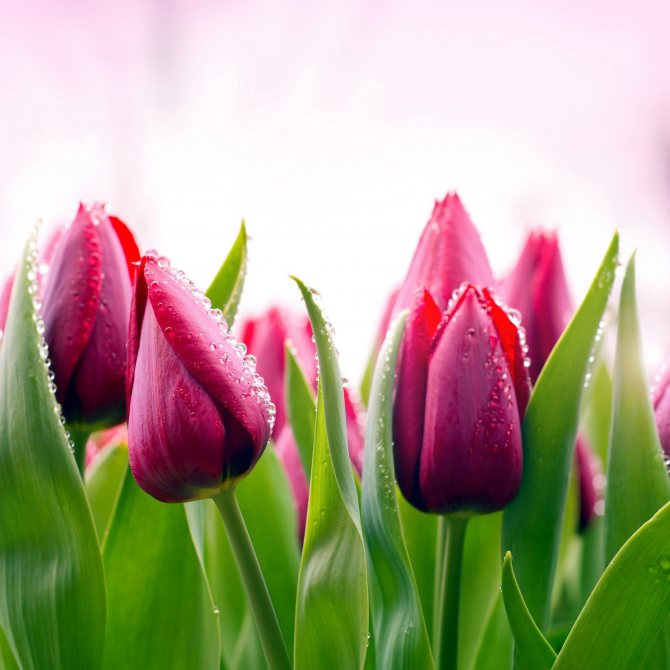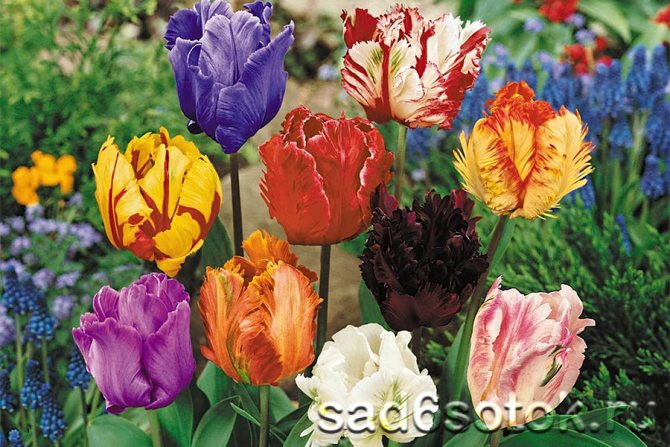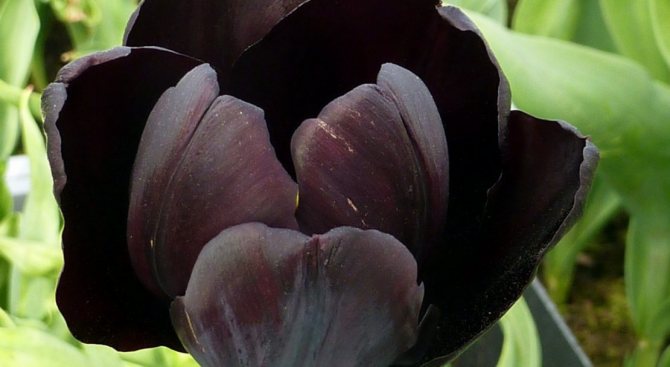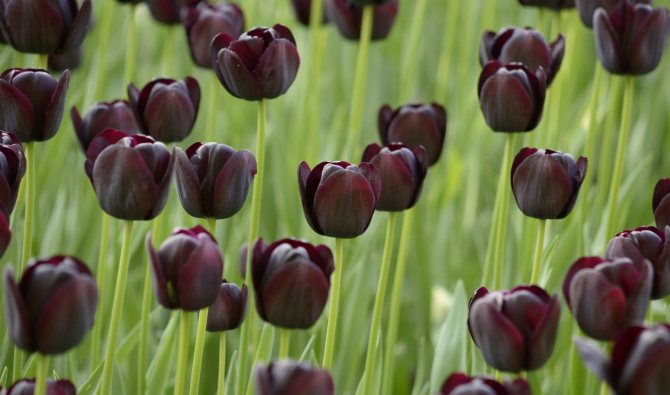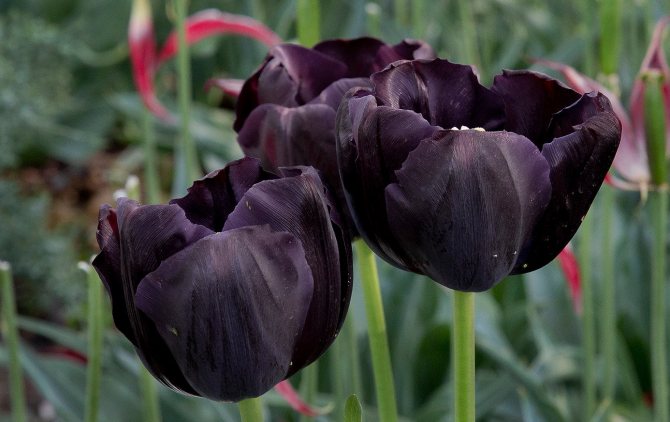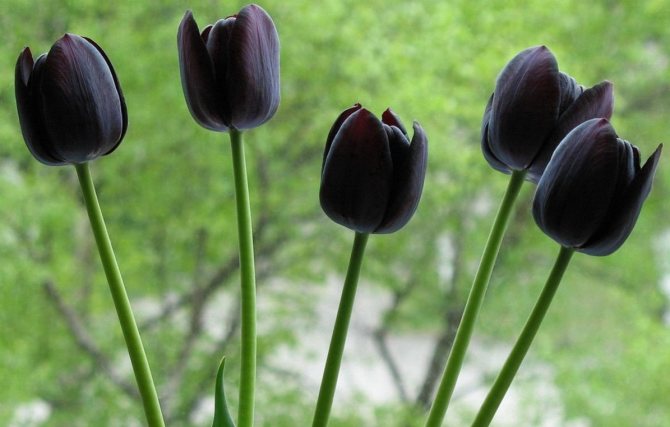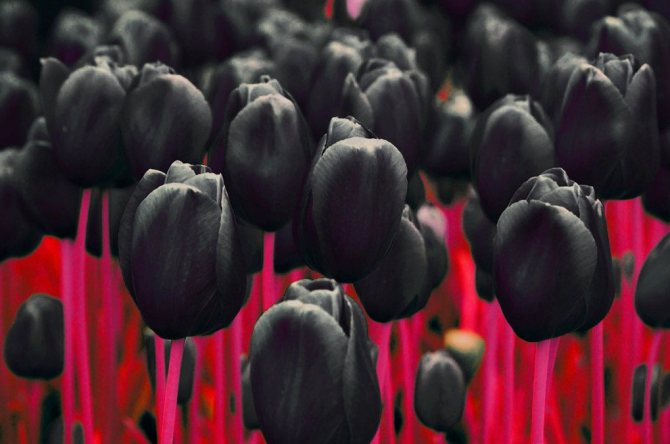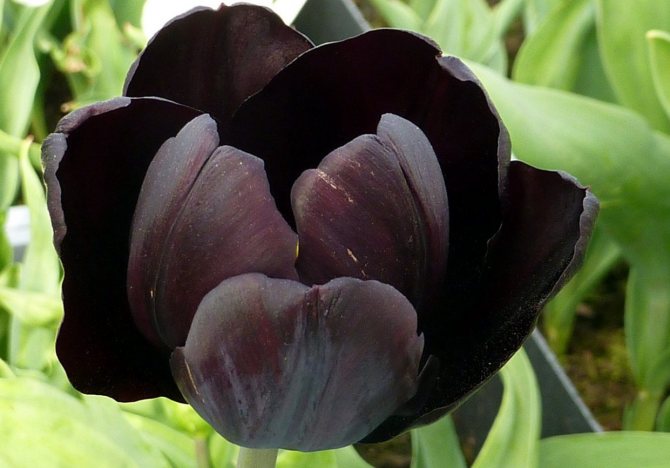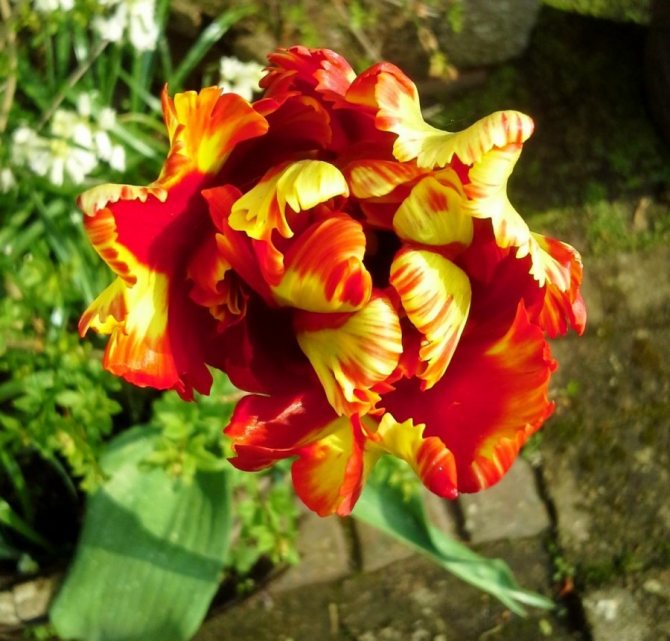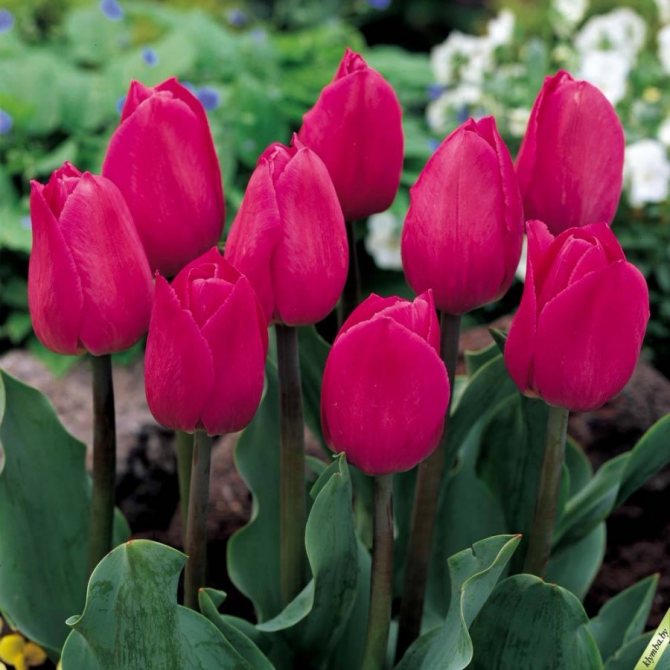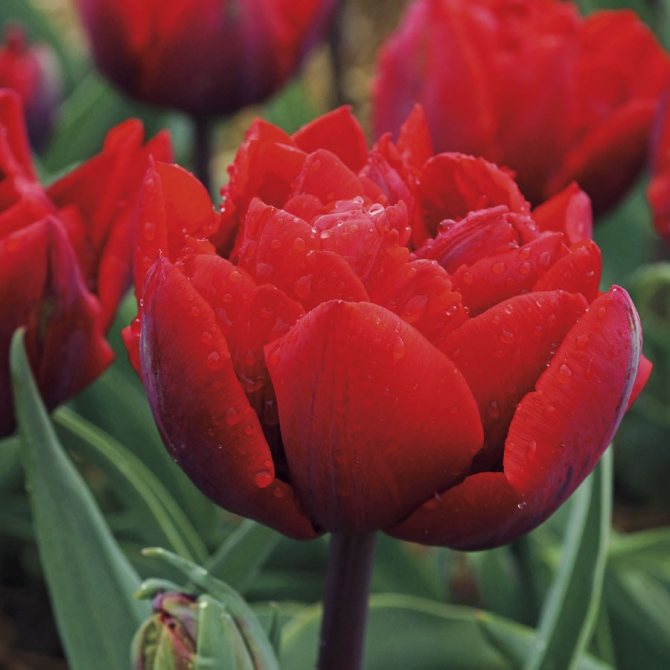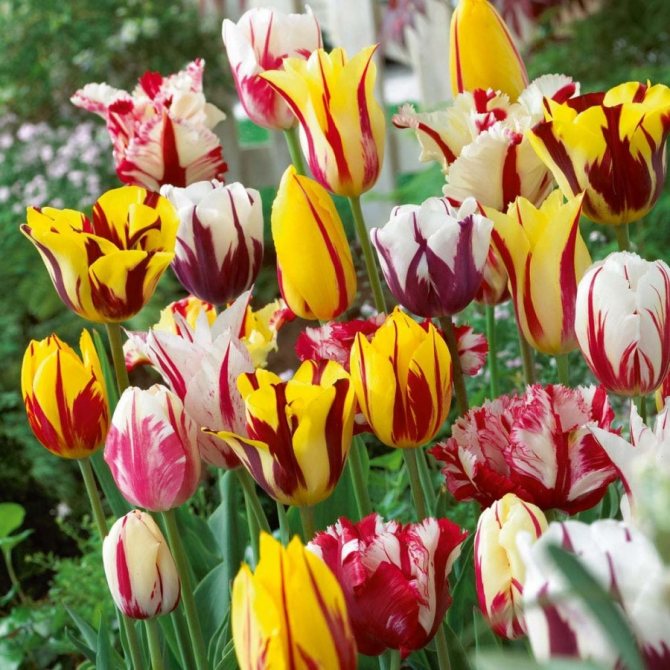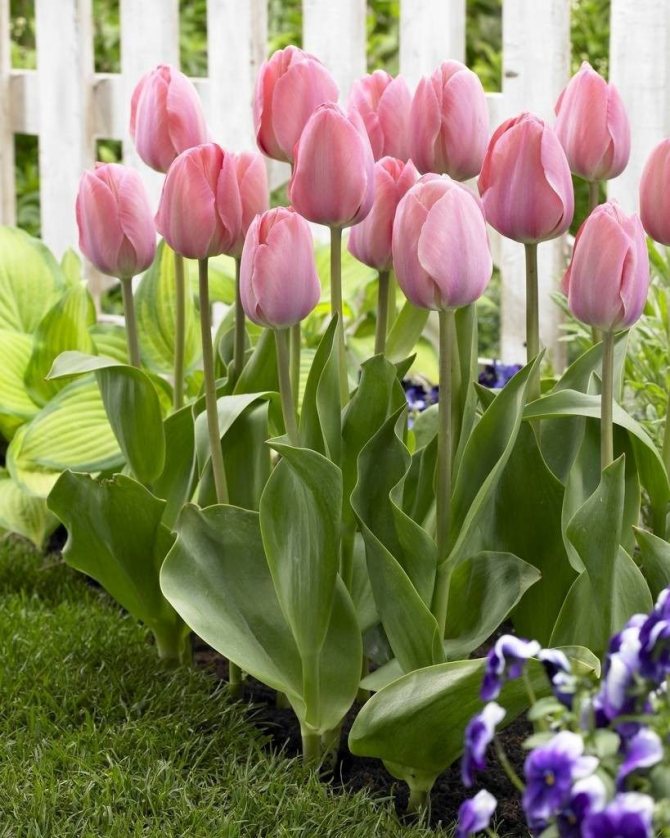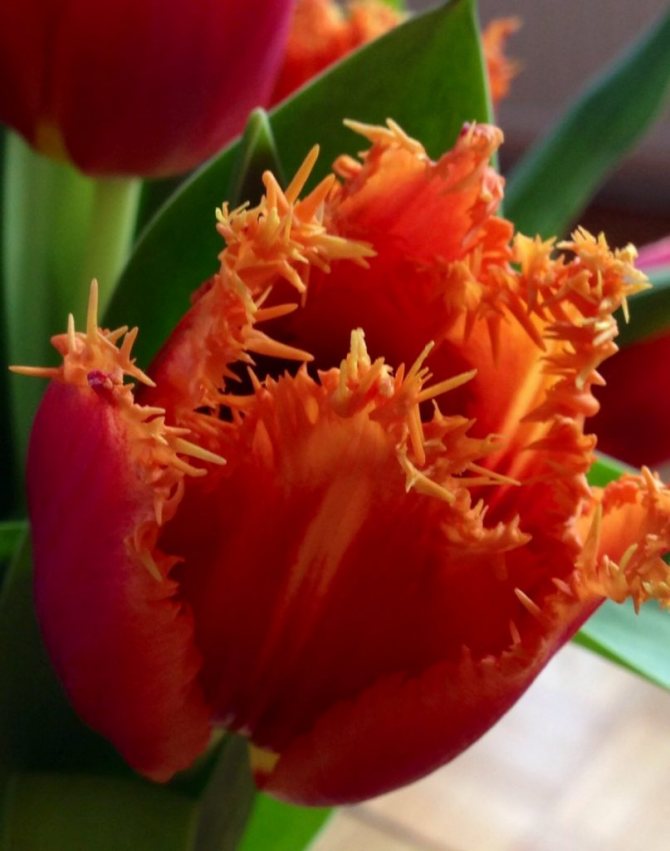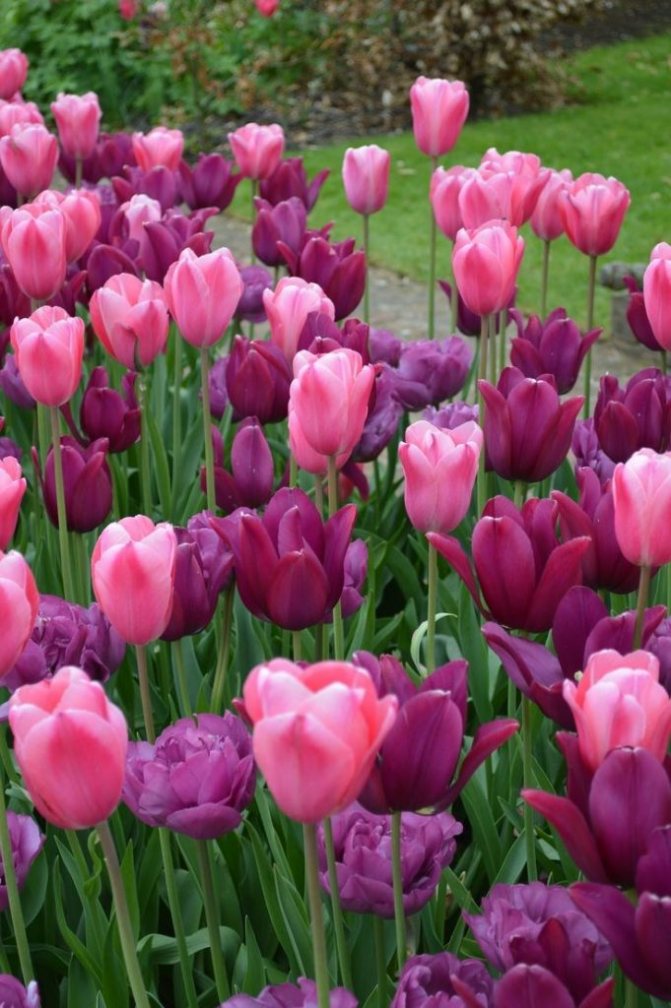Black tulips
Black tulips varieties are called that have a dark, close to black color, which can be dark purple, maroon or dark blue tones. The appearance of black tulips is associated with tulip mania in Holland (1636-1637), which raised interest in rare varieties of this flower to unprecedented heights.
Beginning in the middle of the 17th century, it became known about tulips from the northern Dutch city of Haarlem, which had a rich purple color.
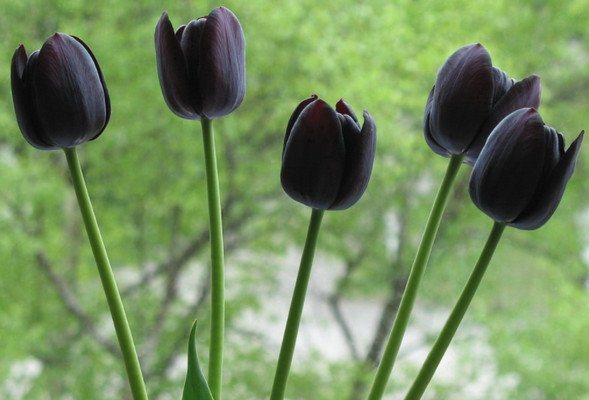
However, the real black color was achieved by the Danish breeder Henk Hagemann only in 1986 at the Institute of Floristics in the Netherlands. This flower is actually such a dark purple color that it looks almost black in any light and on any background.
Did you know? Due to its unusual color, the black tulip was mentioned in the famous novel by A. Dumas "Black Tulip". According to the plot of this novel, the local authorities of the city of Haarlem announced a reward to the author of this unusual flower. This species in the book of Dumas was brought out by Dr. Berle and named after his wife "Rose Berle".
Classification of tulips
The current international classification was adopted in 1969 and includes 15 classes, which are collected in 4 main sections according to flowering time. The last, only in the 80s, the fringed and green-flowered varieties were included in the classification.
- Early flowering.
- Simple early.
- Early terry.
- Medium flowering.
- Triumph.
- Darwin's hybrids.
- Late blooming
- Simple late.
- Lily-colored.
- Fringed.
- Green-colored.
- Parrot.
- Rembrandt.
- Terry late.
- Botanical (wild).
- Kaufman.
- Foster.
- Greig.
- Other wild species.
Description and names of the most popular
The black tulip group includes different varieties. Of course, none of them are completely black. In addition, lighting affects the density of the dark color.
Black jack
This variety has a dark purple color and belongs to the most numerous Triumph group. It has a classic goblet bud that never opens.


It grows up to 40-60 cm and has a strong stem, which makes it easy to cut. It blooms in April-May, suitable for forcing in a greenhouse.
Ronaldo
The maroon variety also belongs to the Triumph group and has similar characteristics. Tulips of this group are considered to be quite unpretentious and can grow in windy areas due to their strong stem and bud. Medium flowering (April-May), suitable for flower beds and for distillation.
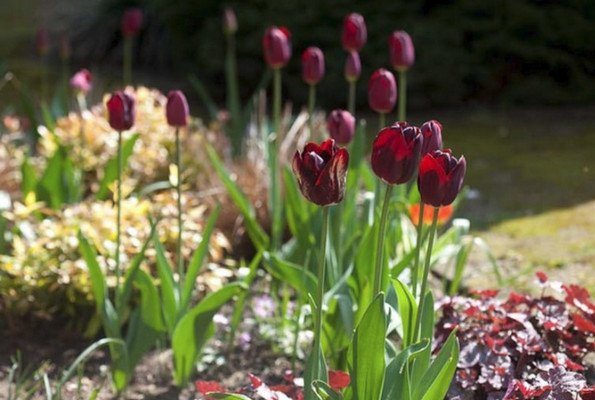

Gardeners note its noble velvety dark color and large flowers that can reach 8 cm.
Queen of night
Black and burgundy "Queen of the Night" is considered one of the blackest flowers. It belongs to simple late-flowering varieties and blooms for about three weeks in mid-May. She has a goblet, large (about 9 cm tall) flower and a strong tall stem.
Did you know? Black tulips are not the only flowers with this color. Among the popular flowers grown by gardeners, there are almost black pansies., irises, maroon mallow, almost black mahogany-grape lily... The "Black Velvet" petunia variety has almost completely black color, and this is not the only petunia with this color, but the darkest among its kind. Among the roses, only one variety has been bred with black and burgundy petals., whose color density depends on growing conditions.
It can grow both in a sunny place and in partial shade. This tulip grows up to 65 cm. Suitable for garden decoration, forcing of medium and late periods, good for cutting for bouquets.
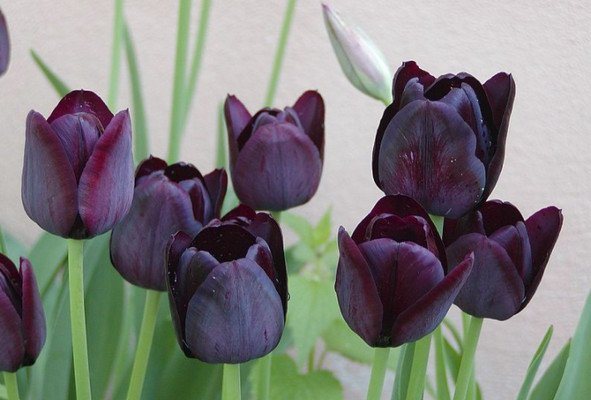

Black and white
Tulips of this variety belong to the variegated Rembrandt tulips. They have a surprisingly contrasting, black and white streaky color. Initially, these flowers were affected by the variegation virus, so they should be planted in the garden separately from other varieties in order to avoid infection.
These varieties are grown with care. The Netherlands even banned the cultivation of variegated species, but they made an exception for some spectacular old varieties.


This is a medium-sized tulip (40-70 cm) with a goblet flower, whose petals can fully open in the sun. It blooms from mid-May and is suitable for cutting.
Black hero
Another tulip of maroon, almost black tones. It belongs to the late terry varieties, which are also called peony for their flower, which has 15-20 petals. The bud is usually up to 7 cm high, and in full disclosure the flower can reach 11 cm in diameter.
The tulip itself grows up to 50-55 cm and has an average growth rate. Flowering occurs at the end of May. It can be planted in the garden, both in the sun and in the shade. It is suitable for cutting and looks great in bouquets. This variety can be used for forcing in greenhouses.
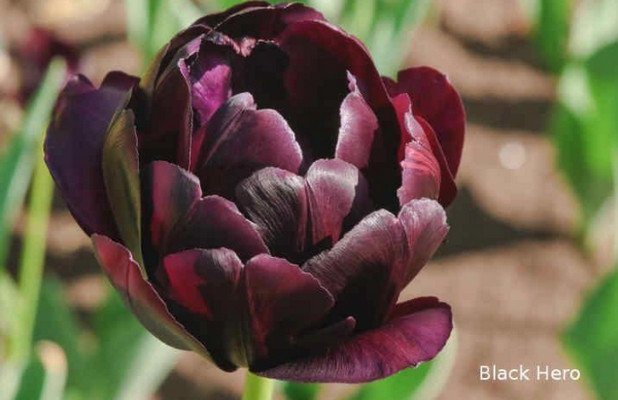

Black parrot
This maroon flower belongs to parrot tulips, characterized by wavy petals, on which green stripes are visible. The head of flowers of this variety reaches a height of 10 cm, and in width, with full disclosure of corrugated petals, sometimes up to 20 cm.
Strong stem reaches 45 cm grows well in full sun and partial shade. Blooms in late May for 2-3 weeks, the plant has an average growth rate. Good for cutting and garden decoration.
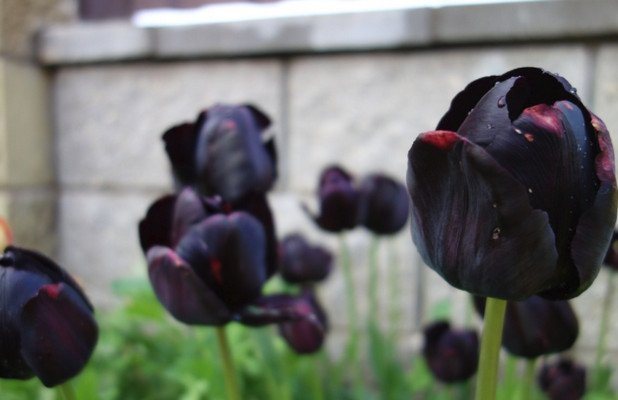

Cuban night
The black tulip of this variety belongs to the fringed species, in which the petals have an interesting needle-like edging along the edge. The color can range from black and burgundy to black and purple. It blooms in May and reaches a height of about 55 cm.
It has a strong stem and is good for cutting, looks great in bouquets. It can be grown in flower beds or used for forcing.
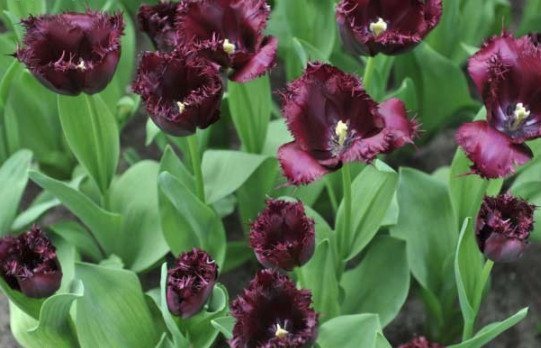

Black Beauty
This tulip is almost black in color with a slight burgundy tone. It belongs to the simple late species and blooms from mid-May, its stem reaches 65 cm.
It has a large goblet flower and is good for cutting, great for decorating a garden.


Tulip - description, characteristics of the flower
It is a herbaceous perennial with bulbs. During evolution, he adapted to life in the mountains, in the steppe expanses and in the desert. He is appreciated for his attractive appearance and unpretentious character. In Holland (Amsterdam), a special holiday is even organized in honor of the flower.
It calmly endures frosty winters, hot and dry summers, rainy and short springs. Development from seed to flowering bush can take 3 to 7 years.
It grows from 10 to 95 cm (depending on the variety). It has an erect stem with a round cross-section.
The plant has adventitious root shoots extending from the bottom of the bulbs. Each bulb has stolons (stems) that grow laterally or vertically downward. There are daughter heads on the bottom. The covering scales of the bulbs have a different texture; they can be pubescent from the inside.
Fleshy leaves are lanceolate, emerald or gray-green with arcuate veins. Elongated plates without petioles, placed alternately, covered with a waxy coating. Decrease in size from bottom to top.
The bush most often blooms only 1 flower from 5 to 10 cm in size. However, there are a small number of varieties with from 2 to 12 buds. Common tulips are yellow, bloody, white.
Varietal specimens of a wide variety of colors: lavender, purple, pinkish, lilac and even black. Some varieties have several inflorescences of various tones on one bush.
Flowers are lily, goblet, star-shaped, fringed, double. After wilting, the fruit ripens - a box with three edges and flattened seeds.
Best conditions for black tulips
Before you can plant these elegant flowers in your garden, you need to choose and prepare the right place for planting the bulbs.
Soil requirements
Tulips love fertile, well-drained soils with neutral or slightly acidic acidity.
The acidic earth should be lime for them. They like sandy ground. It is undesirable that the predecessors were potatoes, tomatoes or eggplants, since these flowers have common diseases with nightshades.
Find out why the acidity of the soil is important for plants, how to determine the acidity of the soil on the site, how to deoxidize the soil, and also how to increase the fertility of the soil.
They love complex fertilizers containing superphosphates, potassium salt and nitrogenous compounds. But usually gardeners add humus or compost.
Lighting selection
Most of these flowers are quite capable of growing in partial shade, but prefer lighted spots. If black tulips are planted in the shade, they will grow there, but weak, and will not look very good.
It is best to choose a place with good illumination for them, especially the varietal tulips, which include black ones, prefer sunny places.
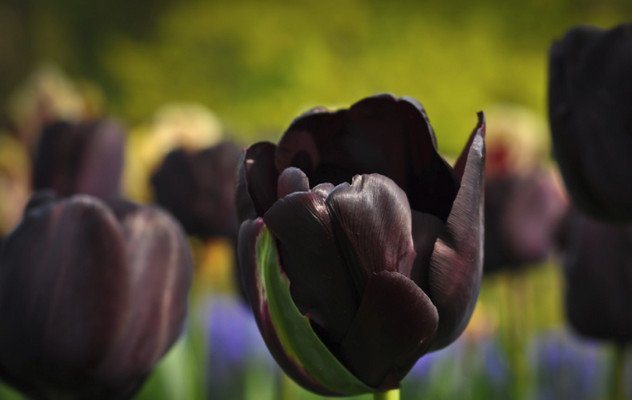

Optimum humidity
The bulbs of these plants do not tolerate waterlogging and stagnant water. Lowlands, in which puddles form in spring, are destructive for them. At the same time, during the period of activity, they need stable light moisture in the soil; during the dry period, they will need watering.
Optimal conditions for tulips
Looking at the photo of tulips, every gardener wants to get a similar result in his own flower bed. At the same time, some note that the plants they have planted do not bloom. Or it happens too late. There are a number of reasons to consider:
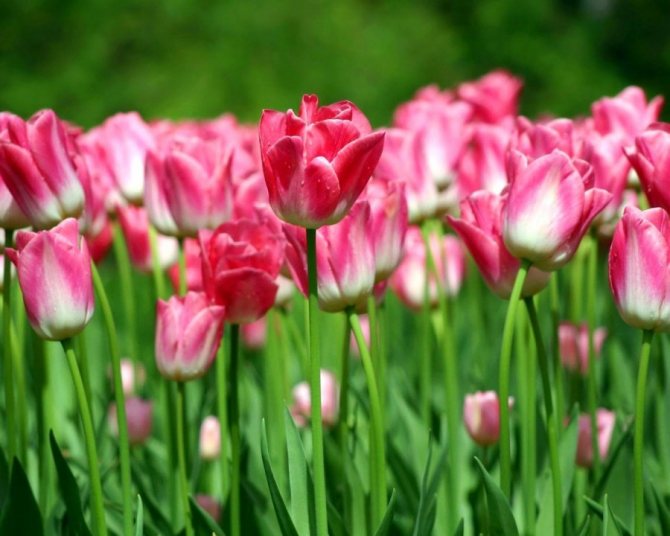

It is not possible to get a healthy sprout from small or damaged bulbs. If it gets into the soil, this planting material can rot or become food for mice.


Tulips planted in the shade may refuse to bloom due to the lack of sunlight they need. Especially if winds and drafts are raging on this piece of land.
Each plant has its own developmental period, non-observance of which can delay flowering for a sufficiently long period.
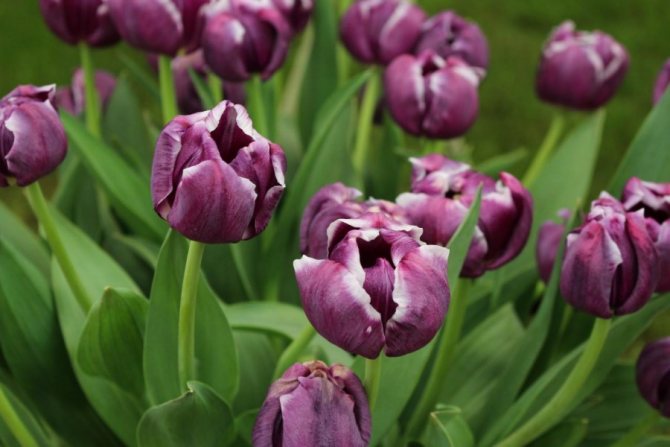

Another mistake a novice gardener can make is the wrong planting depth. If the depth is insufficient, there is a high risk of freezing of the plant, and at the other extreme, it will be difficult for the shoot to emerge.
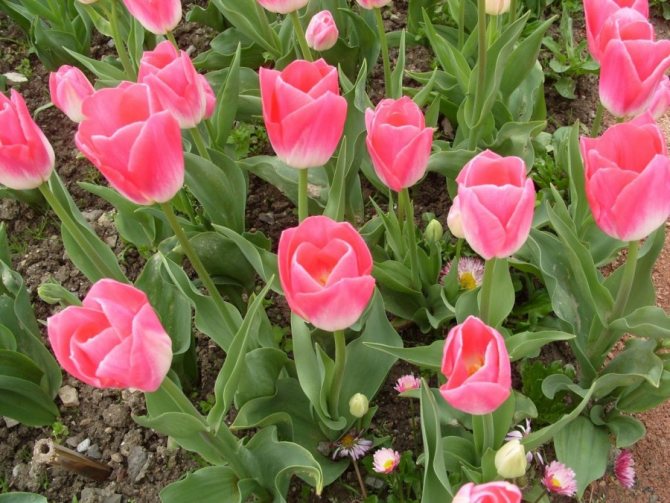

Compliance with the rules for cutting flowers directly affects the health of the plant itself. After the procedure, at least 2 sheets should remain on it.
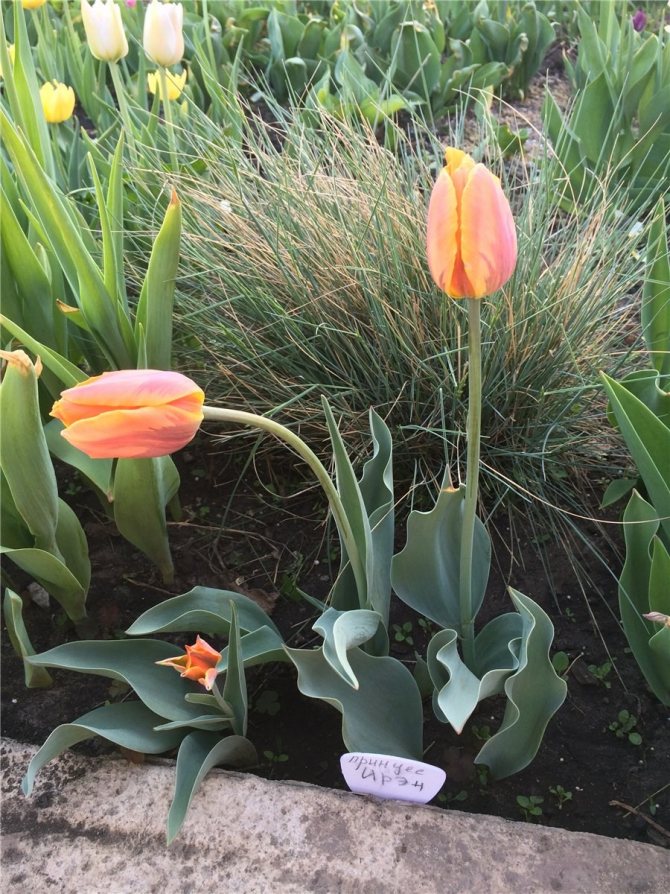

Knowing the features of the development of tulips, you can avoid the above mistakes in order to enjoy an elegant flower bed in the future.
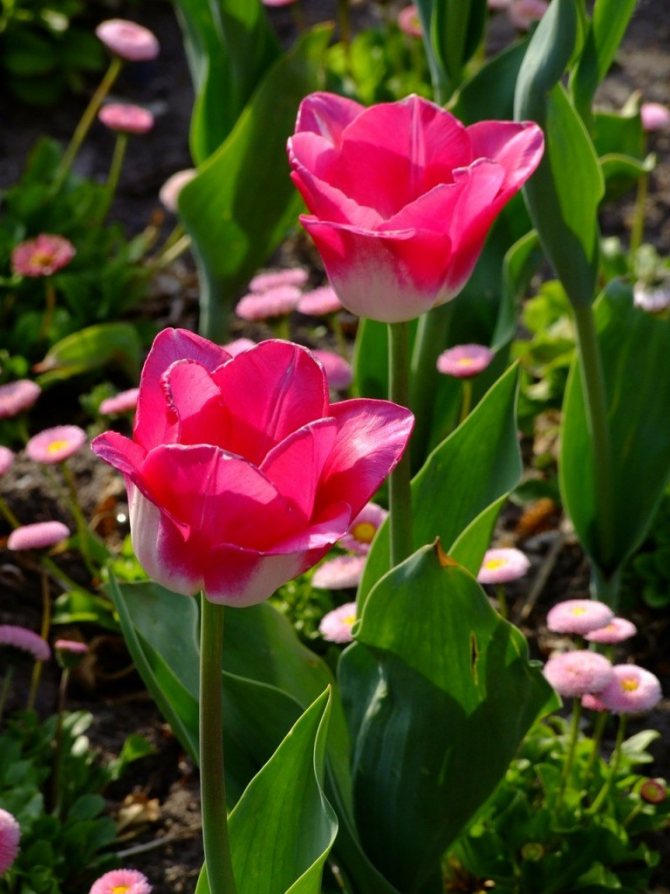

Features and basic landing rules
These bulbs are usually planted in the fall in September-October. Planting is also permissible in spring, but then in the first year you are unlikely to wait for flowering. First of all, when planting, they are guided by the temperature of the soil - it should be + 5-7 ºС.
It should also be borne in mind that the bulbs need 3-4 weeks to root before frost. If they do not have time to take root, they may die or take root in the spring, but the flower from such a bulb will be weak. Early planted bulbs can sprout that will not survive the first frost.
Prepare the soil 2-4 weeks before planting the bulbs. It is dug up along with the introduction of fertilizers (humus, compost or complex fertilizers). The prepared place is covered with a film to prevent the appearance of weeds, and planting material begins in September.
Before planting, it is sorted out and treated with fungicides. Sick specimens are thrown away. Most often, the bulbs are pickled in a weak (0.5%) solution of potassium permanganate.
Video: how to plant tulips correctly The planting depth of the bulbs in the soil depends on their size and the quality of the soil. On light soils, they sink down to three sizes of their diameter, on heavy soils they are planted closer to the surface - two sizes of bulbs.
Large bulbs should preferably be planted in rows with a distance of 10 cm between the planting material and 20 cm between the rows themselves.
Smaller bulbs can be planted in a checkerboard pattern. If they are not planned to be dug out often, then the distance between them should be increased to 20 cm, and with annual digging they can be planted more densely. For 1 sq. m usually accounts for about 50 pieces of large bulbs of black tulips.
When planting, they cannot be pressed into the ground; it is not recommended to ram the ground after burying. You should also not make holes in which water can stagnate; it is better to level the soil after planting.
It will be useful for you to know when is the best time to plant tulips.
Before freezing, the place with the planted bulbs must be mulched.
Mid-blooming tulips
As the name suggests, these tulips do not begin to bloom early - in the third decade of May. But sometimes summer residents achieve earlier flowering, in general, gardeners love the flowers of this group. They bloom evenly, the shades delight with their diversity. It is a completely unpretentious group, does not require special care, it tolerates weather adversities well.
Triumph
Tulips of these varieties are well suited for making bouquets - they have tall, stable stems, the correct flower shape - in the form of a wine glass. Bouquets last a long time, they look very decorative.
Popular varieties:
- Denmark. Very beautiful tulips for cutting, and an unusual color - scarlet with a yellow border. Peduncles are tall and strong, the variety does not disintegrate, does not bend;


- "Alexander Pushkin". These tulips can be admired endlessly, just take a look at the rich purple hue and border. It can be white or pinkish. Ideal for bouquets.
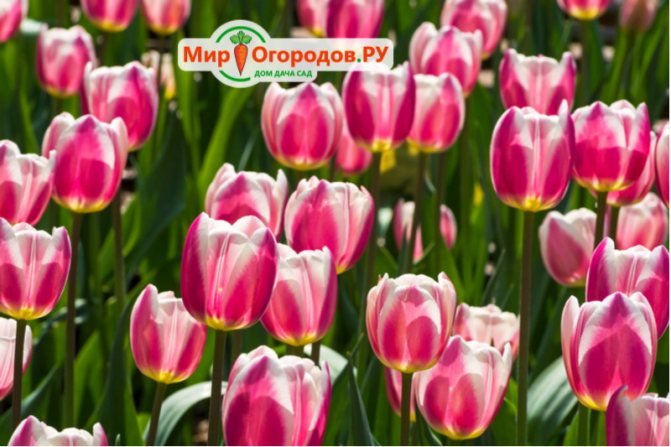

Darwin hybrids
These flowers look beautiful along fences, walls, and can be cut into bouquets. These are giants - up to 80 cm tall. The "glass" of a flower can open wide. Tulips are not afraid of frost and diseases.
Popular varieties:
- "Russian Princess". Has a delicate aroma. The petals are pink-red, the edge is light beige. Ideal bouquets of these flowers for a gift for girls;
- Eric Hofsue. Pink tulips on high stems. The buds are large, the bouquets stand for a long time. The edging on the petals is light. A popular variety.
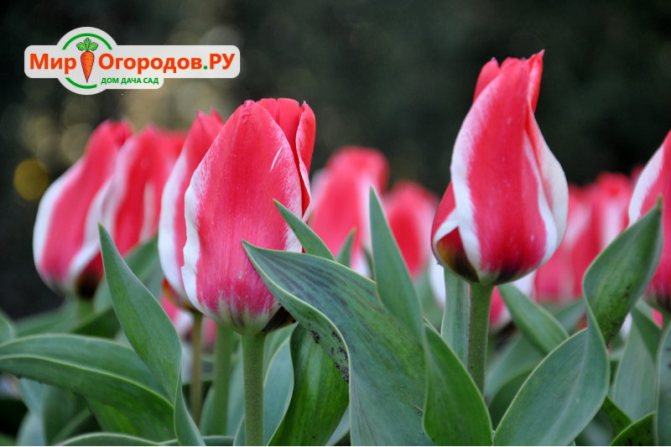

Advice! Also take a look at the following varieties of this group - "Apeldoorn", "Princess Beatrix", "Roland", "Topskor", "Beauty of Apeldoorn", "Diplomat", "Oxford".
Flower care
Caring for black tulips begins as soon as the first shoots appear.Non-sprouted bulbs are removed from the ground so as not to expose other flowers to diseases.


How to water
Adequate watering is an important prerequisite for caring for black tulips. After all, the root system of these flowers is such that they are not able to receive moisture from the deep layers of the earth. They are very fond of moisture, therefore, during the period of bud formation, flowering and two weeks after its completion, they need to be watered abundantly and often.
Important! Be sure to make sure that there is no stagnation of water - this can lead to the process of rotting of the bulbs and the death of the plant.
On average, during irrigation, they spend from 15 to 40 liters of water per 1 sq. m. When watering, it is advisable to exclude the ingress of water on the leaves in order to avoid burns.
To retain moisture, it is recommended to regularly weed and loosen the soil after each rain or watering. It also allows for good weed control, which will interfere with the development of black tulips. The procedure for mulching the soil will not be superfluous.
Cropping flowers
Flower pruning is carried out according to the following rules:
- if tulips were grown for further reproduction, then the flower heads are cut off 4-8 days after the bud opens. This will allow the bulb to gain mass;
- all crumbling leaves must be removed immediately, otherwise they can accumulate in the axils of the leaves and begin to rot;
- it is impossible to cut the stems of tulips after flowering, as the bulbs will stop developing;
- if the flowers are grown for cutting, then after removing the bud and stem, this plant is not suitable for further reproduction, since the bulb stops developing.
The approximate time for cutting and digging the bulbs is two to four weeks after the end of flowering.
Top dressing and fertilization
Fertilizing black tulips is recommended using solutions. If dry dressing is chosen for this purpose, then you need to make sure that when applying such fertilizer, the leaves of the plant are not wet - otherwise burns may form on them.


After feeding, you need to water it abundantly so that the fertilizer is absorbed by the root system along with the water.
The first feeding of these flowers occurs in early spring when the first shoots appear. To carry out this procedure, dry fertilizers are scattered in the form of nitrogen, phosphorus and potassium in a ratio of 2: 2: 1 throughout the site, taking into account the norm of 50 g per 1 sq. m. Then watering is carried out.
The second time, fertilizers are applied before the formation of buds. For this top dressing, it is advisable to use an aqueous solution that will contain nitrogen, phosphorus and potassium in a 1: 2: 2 ratio, that is, the nitrogen dose becomes less and potassium more.
Important! It is categorically impossible to bring fresh or insufficiently rotted manure before planting tulips - the plants will get sick.
Fertilizer consumption rate is 30-35 g per 1 sq. m. The last third feeding is done after the flowers have faded, using a solution of potassium and phosphorus in a 1: 1 ratio at the rate of 30-35 g per 1 sq. m. m. In order to achieve better development of daughter bulbs, an additive in the form of boron and zinc can be added to the fertilizer solution.
Pest and disease control
This type of tulip can be susceptible to such a dangerous disease for them as the variegated virus.... This disease is expressed in the presence of spots, streaks, stripes that appear on the petals and leaves of tulips.
Unfortunately, no methods have been developed to combat this virus, but in order to avoid such a nuisance, the following preventive measures must be taken:
- purchase bulbs for planting from trusted manufacturers;
- when cutting tulips, treat the tool with a disinfectant after each flower, because it is together with the plant sap that such a virus gets on a healthy specimen from a patient;
- if a tulip is seen with signs of this disease, then it must be dug up along with the ground and burned.Pour the remaining hole well with a solution of potassium permanganate.
In August, these beautiful flowers may be susceptible to tobacco necrosis virus... This disease is classified as fungal. With this disease, the tulip has a curvature of the stem, ugly stripes appear on the flower, dark spots on the bulb.
A flower that is affected by such a fungus is dug up together with the ground, the hole is filled with a solution of manganese with the addition of boric acid.
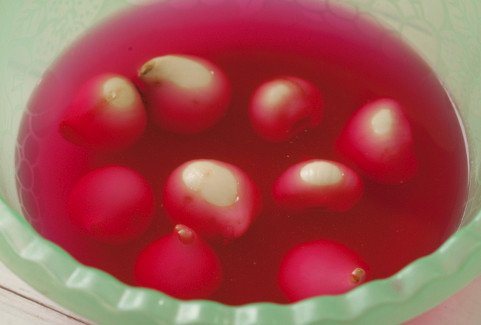

The solution is prepared in such a proportion - 2 g of boric acid is taken for 10 g of manganese, and then this mixture is dissolved in one liter of water. After such watering, it is better to cover the hole with ash. In order to avoid further spread of this fungus, spraying is carried out with a two percent solution of "Fundazol".
Black tulips can be affected by gray, white, brown, wet, soft or botrytous rot. They are especially susceptible to these diseases during the rainy period in spring, when there is a lot of dampness. To avoid such diseases, you need to ensure good drainage of the soil.
As preventive measures against many diseases and pests, during the period when bulbs are dug up on the site and before they are planted, plants are planted that are capable of emitting phytoncides.
These are calendula, marigolds, mustard, etc. In order to avoid fungal diseases of plants, it is recommended to use fungicides. For this purpose, the area is watered with an aqueous solution of any type of fungicide. To prepare such a solution, take 20 g of the fungicide and dilute it in 10 liters of water.
In nature, natural pests of tulips, like many other flowers, are bear... To combat them, glass jars are buried on the site, into which about two-thirds of the water is poured. Having fallen into such a trap, the bear cannot get out. Another pest insect is purple scoop.
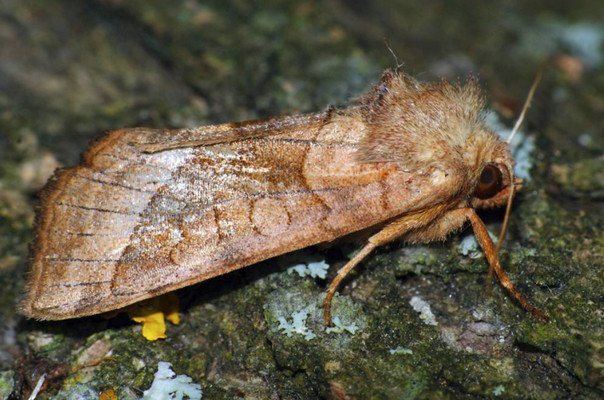

Lilac Scoop To combat it, sprinkle the bottom of the leaves with naphthalene powder.
Did you know? The name of tulips came to us from the Turkish language. Their heads were similar to turbans, so the flower began to bear this name. For a long time, the tulip was a symbol of the rulers of the Ottoman Empire.
Brown onion mite can also cause a lot of trouble for tulips. To get rid of this pest, the bulbs are immersed in water heated to +40 ºС for five minutes. If this mite is found during the growing season, then it is necessary to spray with a 2% solution of "Keltana" or "Rogor".
But when this procedure does not help, the tulips are dug up and burned. After that, tomatoes or radishes are planted in this area, since these vegetables are not afraid of these pests.


Brown onion mite From such pests as bears, snails, slugs, they get rid of using special traps that are placed throughout the site. These can be rags, pieces of plywood, slate.
These insects hide under such shelters and are easier to find for further destruction.
Mousetraps are used for small rodents (for example, mice). Additionally, the bulbs are treated with red lead iron powder before planting, this scares off various pests.
Proper storage of bulbs after flowering
The bulbs are dug up after the tulips have faded and most of the leaves have turned yellow.
Read more on how to care for tulips after they have faded and how to store bulbs before planting.
To find out if the bulbs can be dug up, you must first dig up one of them. Well-formed roots and scale spots will indicate that the bulbs can be dug up for storage.
Dig up tulip bulbs carefully so as not to damage them. Choose a sunny day for this, so that you can dry the bulbs in the sun.
The collected bulbs are sorted and prepared for storage.
To ensure proper storage, it is advisable to adhere to the following rules:
- the bulbs are peeled from pieces of earth;
- make marking - grade, time of collection;
- placed in a wooden box or hung in a bag;
- move for storage in a dry, dark, draft-free room with a temperature of about +25 ° C;
- the temperature regime is later reduced, it should be set no more than +17 ° С.
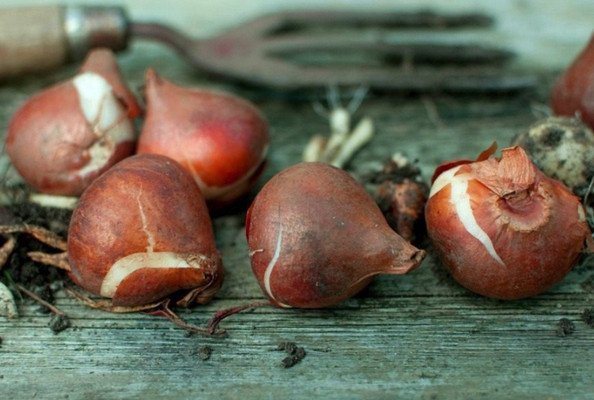

Flowers tulips
The original tulip varieties are representatives of the lily family, which grow mainly in regions where the harsh continental climate prevails.


Fields, summer, flowers tulips
What tulips look like
Hybrids bred for planting in colder and wetter regions have almost no external differences. They were bred in the 11-12 centuries in Persia. The name comes from the word "turban", because the shape of the flower is very similar to the famous headdress. The flowers of tulips are very bright and pleasant, which always remind of the spring-summer mood.
Reference! At one time, these flowers even caused a real fever in Europe, when they began to appear on the shelves of flower shops. Now the peak of demand for tulips falls on the 8th of March, which coincides with the time of flowering.
Where are found in nature
In nature, you can find tulips and daffodils in the hottest countries of Europe: Turkey, Holland, Portugal, Spain, France and other countries. Typically, tulip fields are located in the Mediterranean, Western Siberia, the Caucasus and Central Asia. In some steppes in the Urals and Central Russia, you can find wild plants in the steppes and fields. And purposefully see the fields. Sometimes tulips are found among private gardeners. True, without the necessary knowledge, you will not be able to enjoy the flowering of tulips in your own garden. Flowers do not take root without proper care, cultivation according to all the rules and in the regions of the far north.
When tulips bloom
These plants do not bloom for long. Basically, this is early spring. Most breeders focus their peak flowering in the early days of March, as in the Russian Federation the highest demand is observed on the eve of March 8th. Therefore, there are so many objections about how much tulips cost.
In fact, even in warm countries it is a bit early for flowering as the soil is still frozen. The largest number of tulips should bloom by April. The soil is already moist enough, but the air does not have a high uncomfortable temperature.
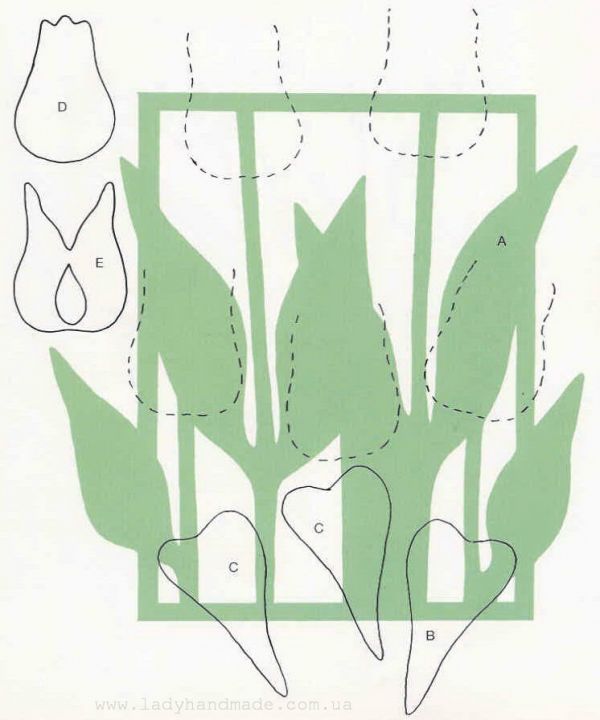

Cutting tulips from paper
In April, flower varieties bloom that grow in the most southern regions. In Russia, especially in the middle lane, tulips bloom in May. There are also summer varieties that bloom in June and even July. The "low season" for these plants to bloom is autumn and winter. Some varieties need to be transplanted for wintering in the warmth (put on the table near the window), and when to dig out tulips and daffodils, you need to clarify for each specific variety in a particular region. And in the spring, it is better to feed the fruits with something.
What color are tulips
Gardeners are used to dividing colors into traditional ones, which nature presented to us, and exotic ones, which owe their unusual shades to biologists.
So, traditional tulips:
- Red and scarlet. It is customary to give as a sign of your love to your beloved or adored person.
- Pink tulips. They are given both to loved ones and as a token of gratitude and for any other reason.
- Yellow and orange. Previously, yellow tulips were brought as a gift in case of impending separation, while men could give them to their women when parting and as a hint that feelings had cooled down. Now this superstition is gone and they give yellow plants as a sign of the wish of wealth.
- White. They are also given to young girls as a symbol of forgiveness. Fans of white are very fond of white tulips.
Reference! Colored bouquets from a collection of pink, yellow and white flowers are very popular.
What exotic varieties are there?
- Red-brown flowers with a yellow border. Dark colored tulips are found mainly in the Abu Hassan variety.
- Purplish white, milky pink, pale pink with different stripes.
- Delicate lilac, burgundy and fuchsia can also have stripes and spots that add exotic.
- There are even black ones with a thick fringe Black Beauty. In fact, the hue is closer to dark blue or dark purple. It is very difficult to find such tulips in the store, and they are snapped up quickly.
Types of tulips and their hybrids
The group has an unusual name, all because all the flowers that did not fall into the previous classes were assigned here. There are a lot of varieties here. We will name the main types of tulips, look at their photos. There are only four names, but the flowers themselves are very diverse, since their breeders mix with each other. Tulips are different, the flowering time can be both early and late. Of course, the varieties are also different in appearance.
Kaufman
As a rule, they are pleased with flowering already in April. Flowers are undersized, ideal for decorating borders, can be grown in trays on summer verandas. The shape of the inflorescences resembles a star. They can decorate rockeries, alpine hills, they are not afraid of shadows. These tulips are crossed with the next two and get different hybrids. The class was bred in 1877.
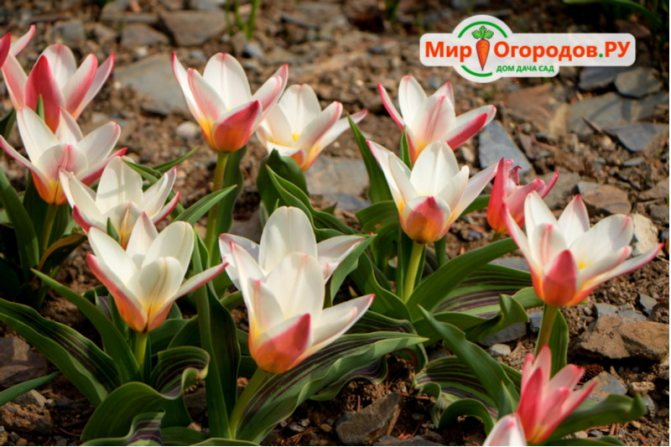

Foster
Tulips are large - up to 15-18 cm in diameter. They bloom in spring, they are often planted in composition with other primroses or flowers that open their buds in early summer. Shades of petals can be different, varieties are not afraid of frost. In culture since 1905.


Greig
Most often, tulips have either two shades on one flower, or they are just red. Ideal for decorating paths, can be planted at the base of the rock garden. Inflorescences are large, unpretentious class with strong stems. The petals have jagged edges. The class is used for crossing with Kaufman and Foster tulips. In culture since 1872.


Wild
These tulips have also been classified, but many varieties are quite unremarkable when compared to other groups. It is worth noting that three classes that were listed above are also classified as wild - Kaufman, Foster, Greig. The group also includes tulips - "Borshcheva", "Alberta", "Velikie", "Tubergena", "Julia" and a number of other varieties. Not all flowers surprise with shades, saturation, petals can be small in size. But these tulips are absolutely unpretentious, that's why they are wild. They can bloom up to a month in time. Breeders use wild varieties to create new hybrids.
The healing properties of tulips
- The chemical composition of tulips confirms that this plant contains such useful substances as tuliposides A, B and C, as well as the alkaloid tulipine. This is the reason for the antibacterial and antifungal properties of the tulip.
- In folk medicine, this flower is used in the treatment of certain cardiovascular diseases, because tulips have cardiotonic properties.
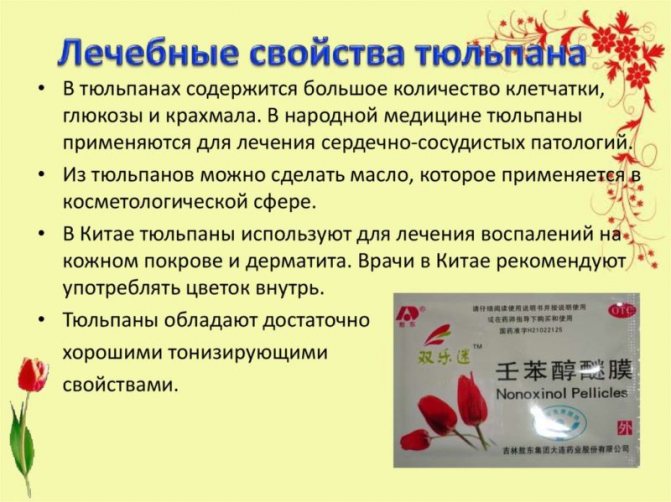

Tulip flowers benefits and treatments
- Chinese folk healers use tulip tinctures for diarrhea, indigestion, various types of poisoning, as well as for tumors.
- Tulip oil is used in the treatment of certain dermatological diseases. It is also used in the manufacture of nourishing face masks in the field of home cosmetology.
- The use of a tulip will be advisable for inflammation of the skin, for rheumatism, for arthritis and for arthrosis.
Read also: The length of the roots of African ficus reaches 120 meters
Harm of tulip flowers and contraindications
- Before being treated with these plants, you need to know that only edible varieties of the tulip flower have medicinal properties. Gunther's tulip, for example, is highly toxic. The Gesmer tulip is also toxic.It is forbidden to consume them inside because of the danger of death and severe intoxication of the body.
- The tulip bulb contains some allergens. With constant contact of a person with this flower, especially in florists, the development of "tulip dermatitis" may be likely. Symptoms of this disease: tingling in the fingers, itching and peeling of the skin, eczema, nail damage.
- The use of tulips is categorically contraindicated during pregnancy, breastfeeding and among children.




